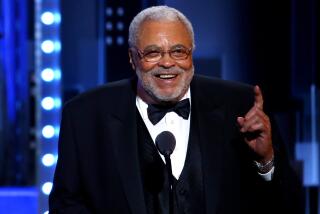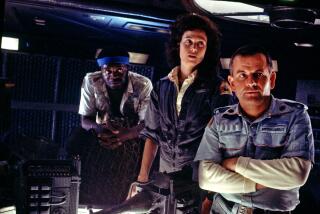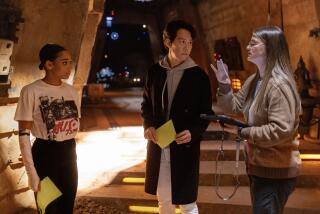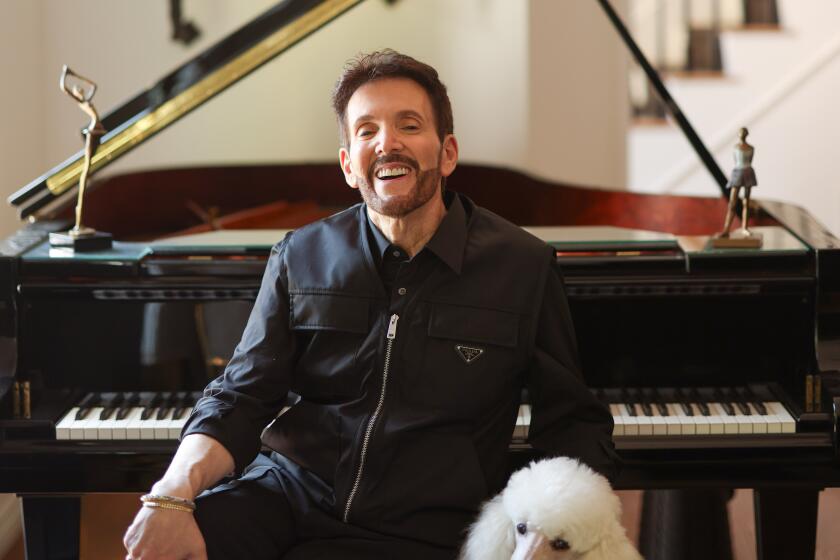‘Rogue One’ director Gareth Edwards on bringing CG Tarkin and Leia into his galaxy
With the clock ticking down on the biggest film of his career, “Rogue One: A Star Wars Story,” director Gareth Edwards wrestled with the high stakes ace up his sleeve: using computer graphics to digitally insert actor Peter Cushing, who died in 1994, into Edwards’ new “Star Wars” film as the iconic villain Grand Moff Tarkin.
Warning: “Rogue One” spoiler talk ahead.
“We were ultra-paranoid about it,” Edwards told The Times ahead of the home video release of “Rogue One,” which crossed the billion-dollar global box office mark just 39 days into its December release. “Even a month away, there was this feeling of, ‘Is this going to work? Can we do this?’ ”
Plenty of pressure already hung over “Rogue One,” the first standalone side story in the “Star Wars” franchise. Anchored by a new heroine named Jyn Erso (Felicity Jones), recruited into leading a team of characters on a mission to steal the plans to the Death Star, the prequel to 1977’s “Star Wars: Episode IV — A New Hope” would tell a darker, more violent tale than its predecessors in a galaxy far, far, away.
And it required the presence of a familiar face.
ILM’s challenge for this movie was ‘can you do this one shot?’
— “Rogue One” director Gareth Edwards
“In the early conversations about the end of the movie, we knew we were going to hand it off in some form, like passing the gauntlet to Princess Leia,” Edwards said of the film’s final sequence, in which the Death Star plans land in Leia’s hands, leading into the events of “A New Hope.”
In Austin, Texas, to speak at the South by Southwest festival last month, Edwards recounted the challenge. The task of creating a young CG Leia by digitally blending Carrie Fisher’s face, and a single word of dialogue she delivered in 1977 — “hope” — with the motion-capture performance of actress Ingvild Deila, went to Industrial Light & Magic. Fisher, who died Dec. 27, did not film scenes for “Rogue One.”
“We knew we were probably not going to be able to get away without showing her without it feeling like a cheat,” Edwards said. “You could do some gag where you just saw the back of her. ILM’s challenge for this movie was ‘can you do this one shot?’ And as we carried on the conversations about story, it became clear you can’t really tell the story of the Death Star without Tarkin — and therefore, Peter Cushing.”
Edwards consulted with John Knoll, the “Star Wars” visual effects veteran and ILM exec who devised the premise of “Rogue One.” Once the Cushing estate approved of the plan to use the late actor’s likeness, said Edwards, “there was a lot of pressure on ILM [to deliver].”
The technology has certainly advanced since the days of “The Polar Express,” an oft-cited example of disquietingly imperfect photorealistic human CG. In spite of the film’s Academy Award win for visual effects, even Edwards seems to agree with critics of “Rogue One’s” Tarkin, who appears in several scenes built from archival material of Cushing and a new motion-capture performance by actor Guy Henry, a process Knoll has described as akin to “prosthetic makeup.”
“We had something that looked like Peter Cushing probably six months before the end,” said Edwards. “But there was something not quite right about it. And that ‘not quite right’ is really hard to explain. The one thing we’re perfectly designed for is to recognize the subtleties in emotion of the human face. It’s kind of what we do all day long, every day. To present all those nuances through animation and through a computer interface is nearly impossible.
“This idea that computers are going to replace actors — I have definitely come out at the end of this process thinking, ‘That’s not going to happen anytime soon.’ It’s really not going to happen for a long time. This was a lot of blood, sweat and tears by really talented animators, and it took a solid year of trying to get the handful of shots that we ended up with. So trying to make an entire movie is going to be a lot of work for someone.”
The filmmakers also chose to retroactively lend the original trilogy a modern lens by reverse-engineering one element absent from the first “Star Wars”: diversity.
Inclusion was a 21st century must, according to Edwards, who cast Diego Luna, Riz Ahmed, Donnie Yen, Jiang Wen and Forest Whitaker as supporting members of “Rogue One’s” multiethnic central band of heroes.
The first “Star Wars” film, shot and cast in London, has been pored over by generations of fans so meticulously that even background extras have earned their own fandoms. But “A New Hope’s” heroes also looked like “the equivalent of the RAF [Royal Air Force],” said Edwards. “This kind of white male squadron which was a symptom of the 1970s a little bit, and of the fact that they shot in Britain. But the world’s moved on a lot since then.”
As a result, “Rogue One” and “Star Wars: Episode VII — The Force Awakens,” starring Daisy Ridley and John Boyega, mark a new era for diverse representation in the “Star Wars” universe. Once Jones was cast as “Rogue One’s” lead, according to Edwards, the rest of the ensemble came together with balance in mind.
“It was like ‘Great. We have a Western white female, so that means we be doing the opposite a little bit with some of the other choices,’ ” he said. “You have a talking fish in a movie. You should have most of humanity represented.”
Meanwhile, Edwards, 41, a lifelong fan of the franchise who once made a birthday pilgrimage to the Tunisia set of Luke Skywalker’s home to drink blue milk, also made sure to give himself the most important cameo in “Rogue One.”
“The guy gets the [Death Star plans], someone else presses the button and closes the door on Darth Vader, he shouts, ‘Launch!’ and you see this other guy running to pull a lever,” he smiled. “I’m the other guy! I like to think I saved the whole rebellion. Yeah, I abused my power.”
In theory, after doing ‘Star Wars,’ you get to do whatever you want next... so the next one had better be good.
— “Rogue One” director Gareth Edwards
And after first pitching the “Rogue One” story to “Star Wars: Episode VIII — The Last Jedi” director Rian Johnson, Edwards teased, he shot another scene for the Dec. 15 release.
“I got to have a cameo in it, which was fun, so I’m technically in it unless they cut it out,” said Edwards. “I like to think that the one in Rian’s movie is the grandson of the character in ‘Rogue One.’ ”
Not bad for a “Star Wars” fan who made his directorial debut with a tiny crew and a $500,000 budget on the indie pic “Monsters” just seven years ago.
“When I was growing up, there were lots of films I pictured wanting to make if I ever got a chance to make films,” says Edwards, who adds that he plans to travel and dream up his next project now that “Rogue One” is out on DVD and Blu-ray.
“It’s exciting! I think there’s a great opportunity that comes, because in theory, after doing ‘Star Wars,’ you get to do whatever you want next. So the next one had better be good.”
More to Read
Only good movies
Get the Indie Focus newsletter, Mark Olsen's weekly guide to the world of cinema.
You may occasionally receive promotional content from the Los Angeles Times.











